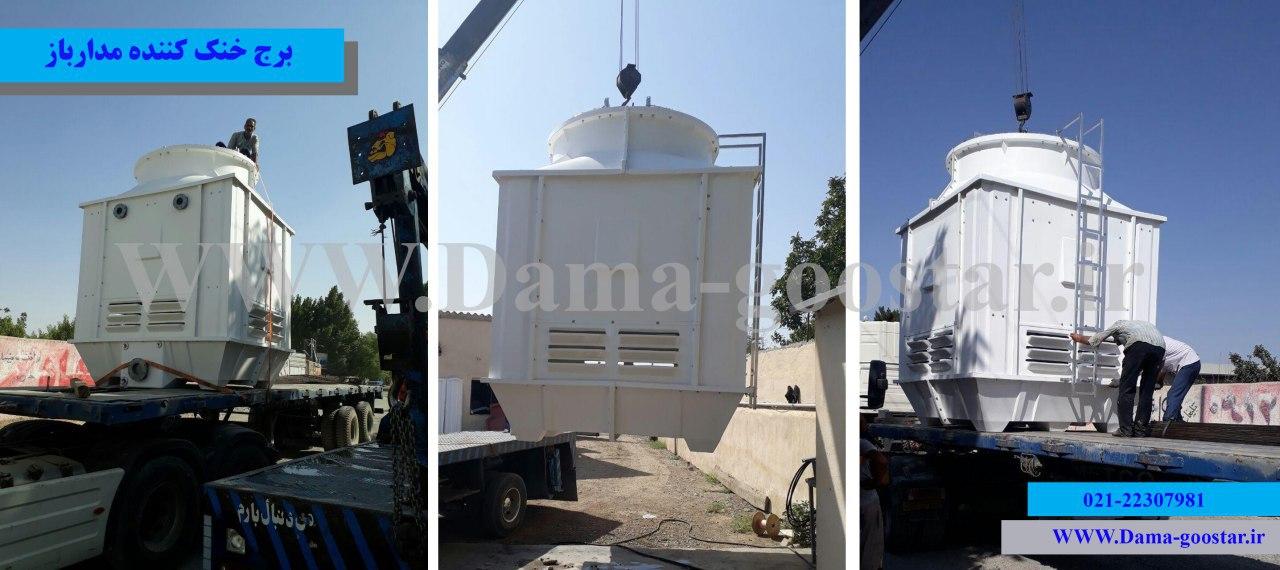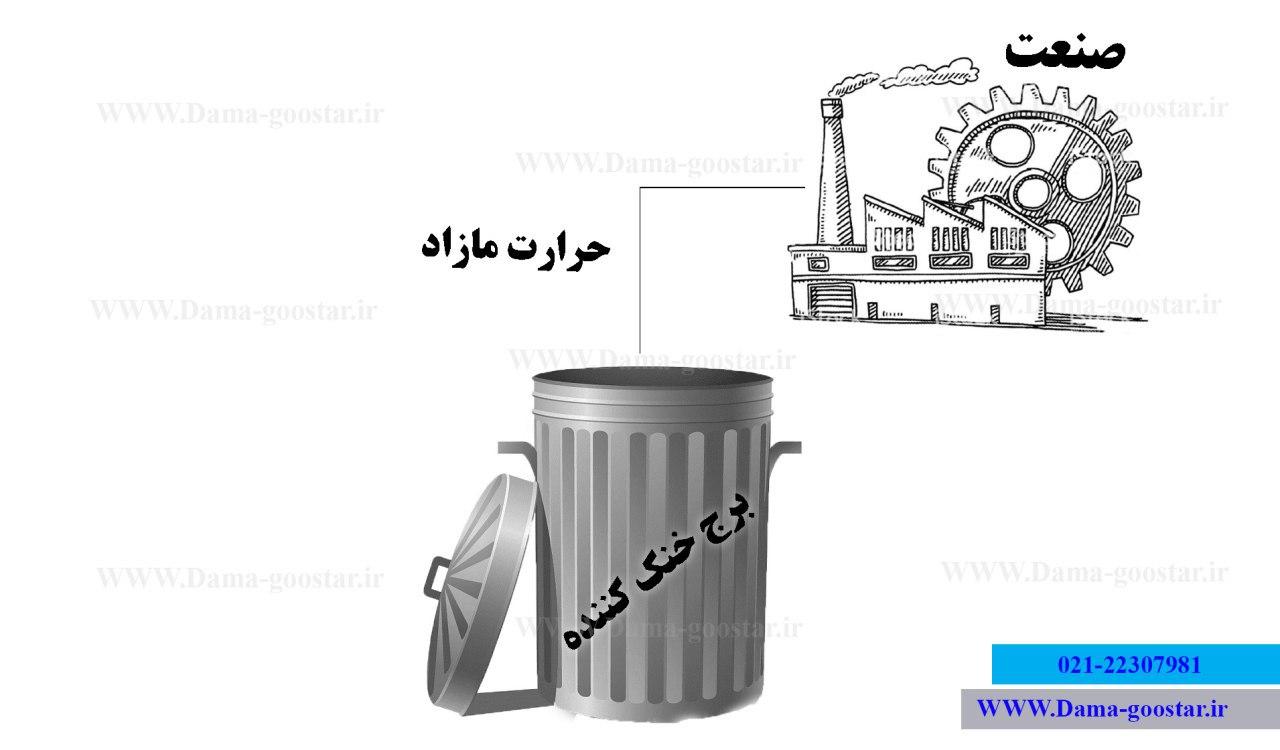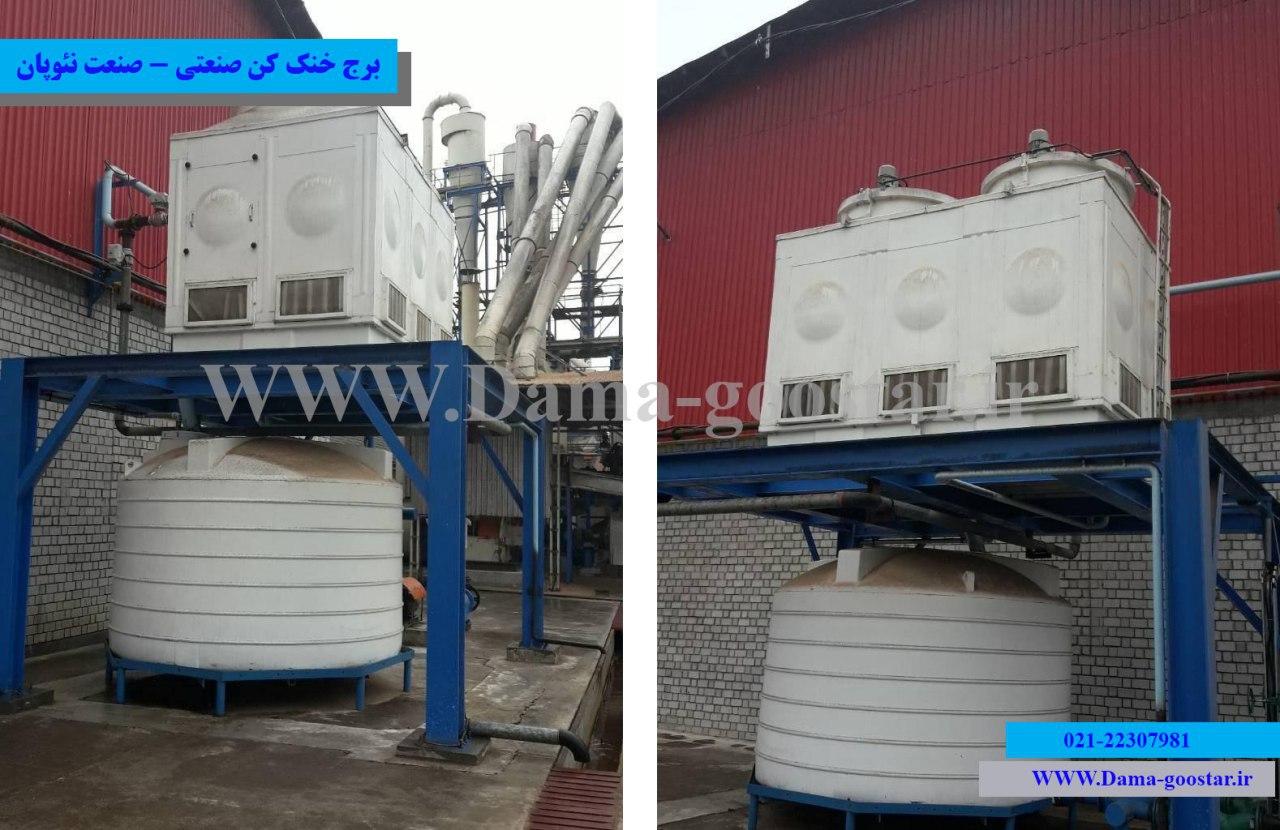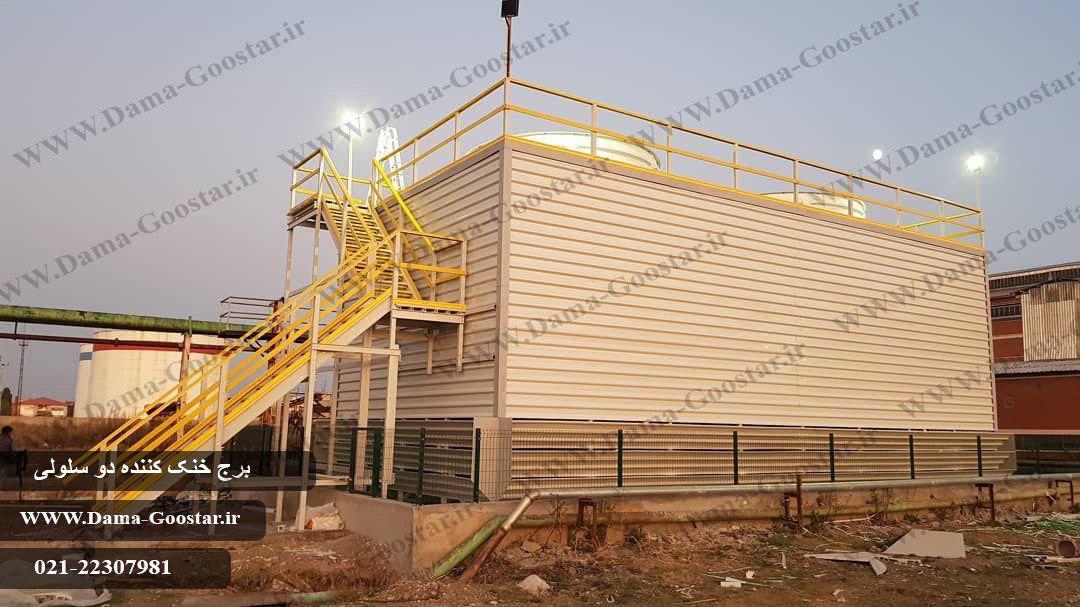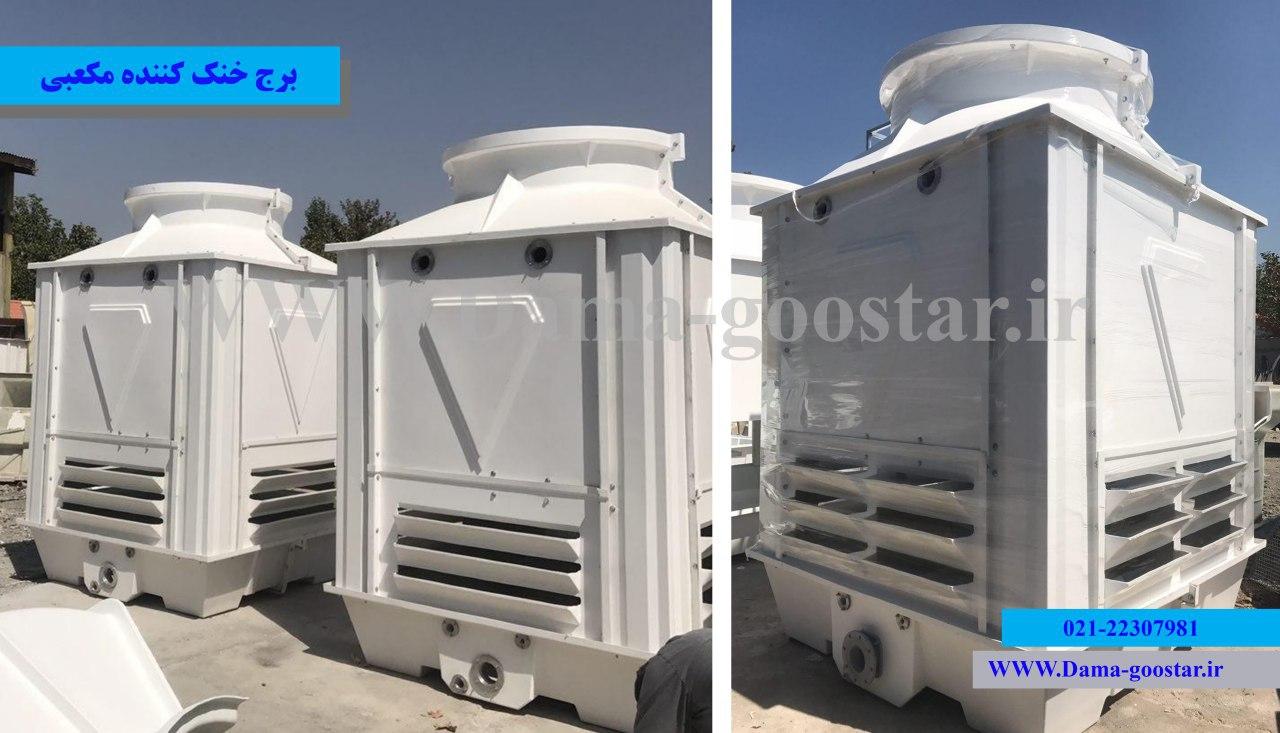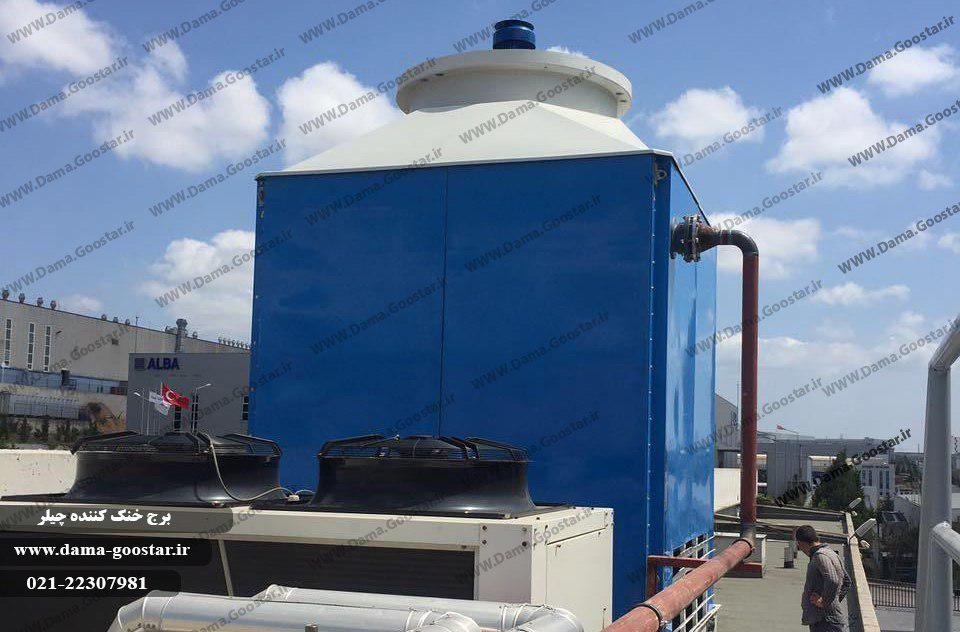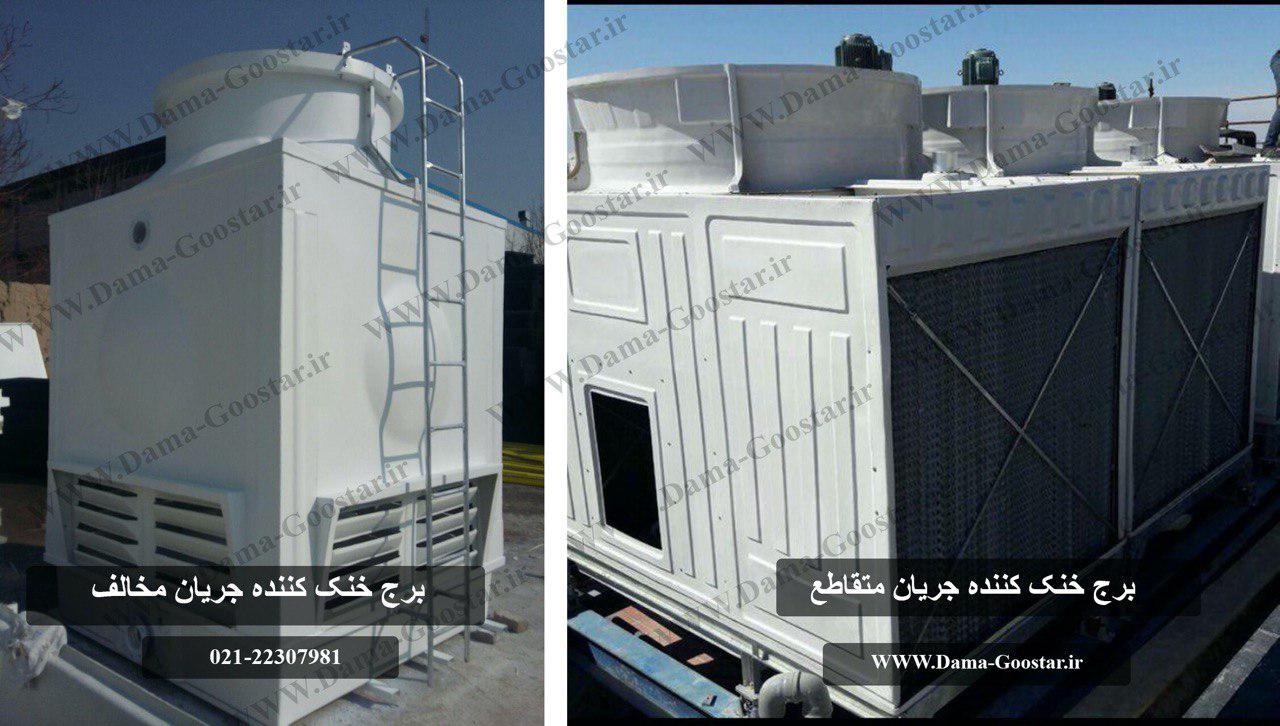![]()
برج خنک کننده جریان متقاطع یا برجخنککن کراسفلو (Cross Flow Cooling Tower) نوعی سیستم مدارباز جهت خنک نمودن آب محسوب میشود. برج خنککن جریان متقاطع برای اولین بار توسط شرکت ابارا در ژاپن برای خنککردن آب در مناطق شرجی ارائه گردید و به همین دلیل در صنایع برودتی تحت عنوان برج خنک کننده ابارا نیز شناخته میشود. در برج خنک کننده جریان متقاطع جریان آب از بالای برج به سمت پایین پاشیده شده و هوا از قسمت پایین توسط یک فن یا پروانه در جهت عمود بر جریان آب دهش یا مکششده و در این ارتباط جریان آب در سطح عرضی کولینگ تاور خنک میگردد. نوع ساختار برج خنک کننده کراس فلو به شکل هندسی مستطیل میباشد و جریان هوا از دو طرف توسط لوور یا دریچه های ورودی سرتاسری به داخل کشیده میشود.
چرا برج خنک کننده جریان متقاطع؟
برج خنک کننده وظیفه دفع گرمای حاصل از تجهیزاتصنعتی گرمازا را به عهده دارد و از آنجا که خود نوعی مولد سرمایش تبخیری محسوب میشود سبب افزایش رطوبت محیط میگردد و درنتیجه با افزایش رطوبت هوا ظرفیتبرودتی کولینگ تاور نیز کاهش مییابد. باتوجه به مطالب ذکرشده، برجخنککننده مخالف دستگاه مناسبی برای خنککاری آب در مناطق مرطوب به حساب نمیآید. در این طور مناطق از چیلرها جهت خنکسازی آب در یک سیکل تراکمی یا جذبی استفاده میشد. به دلیل مشکلات متعدد از جمله هزینهبالای خرید چیلر و تعمیر و نگهداری سخت این تجهیز شرکت ابارا تصمیم به طراحی برجخنککننده ابارا یا کراس فلو با سیستم گردشهوا به صورت متقاطع شد.
پس از تکمیل این طراحی در واقع هوای محیطهای مرطوب که دارای رطوبت زیادی بودند در تمامی لایهها به صورت یکنواخت در تماس با آب قرار میگرفت و راندمان برجهای خنککن با تغییر نوع گردش هوای ورودی بسیار افزایش پیدا کرد. به بیانی علمیتر و واضحتر برجخنککننده جریانمتقاطع سبب تماس هوایتازه در تمامی سطوح و لایههای پکینگ با جریانآب میشود و دیگر همانند برجخنککننده جریانمخالف هوا خاصیت رطوبتگیری خود را در لایههای بالاتر از دست نخواهد داد.
نحوه کارکرد برج خنک کننده جریان متقاطع یا کراسفلو
برجخنککننده کراسفلو همانطور که از نام آن مشخص است با ورود جریان هوا به صورت عرضی در سراسر سطوح خنککننده(پکینگ ها) سبب برخورد هوا و آب به صورت عمودی و درنتیجه کاهش دمای آب میشود. به دلیل ورود هوا به صورت عرضی در تمامی لایههای پکینگمدیا هوایتازه در ارتباط با آب قرار خواهدگرفت و از این رو اگر هوایتازه ورودی به برجخنککن دارای رطوبت بالایی باشد قابلیت خوبی است که برجخنککننده جریانمتقاطع از هوای تازه بهترین استفاده را مینماید. درواقع به دلیل همین عملکرد ورودی جریان هوا از برجخنککننده جریانمتقاطع بیشتر در مناطق با اقلیم رطوبتی و مرطوب (شرجی) استفاده میشود. ورودی هوا در برجخنککننده جریانمتقاطع از دو طرف این دستگاه طراحیشده و به دلیل نحوه چگونگی ورود هوا این لوورهای مکش هوا به صورت سرتاسری در دو طرف برجخنککاری تعبیه میگردد.
مقایسه بین برج خنک کننده جریان متقاطع و جریان مخالف
دارای ارتفاع کمتری در مقایسه با انواع کولینگتاور جریانمخالف میباشد.
نیازمند مساحت بیشتری جهت خنکسازی میباشد و آب در برجخنککن جریانمتقاطع در یک جریان سطحی خنک میشود تا در ریزش در لایههای مختلف(ارتفاع).
نوع پکینگ یا سطوح خنککن در برج خنککننده جریانمتقاطع از نوع شانه تخممرغی میباشد ولی نوع پکینگمدیا در برج خنک کننده جریانمخالف از نوع فیلمی یا آبشاری میباشد.
افت فشار کمتری دارد(به دلیل ارتفاع کمتر) و این موضوع سبب کاهش توان مصرفی پمپ سیرکولاتور نسبت به انواع برجخنککن جریانمخالف میشود.
امکان ارسال در ظرفیتهای بالا به صورت غیرترافیکی و مونتاژ درب کارخانه (به دلیل تولید به صورت مستطیلی)
نوع نازلهای بکاررفته در برجخنککننده جریانمتقاطع از نوع پروانهای میباشد و درحالی که در کولینگتاور کانترفلو از انواع نازلهای دایرهپاش و نازل مربعپاش جهت پاشش آب استفاده میشود.
ورودی آب از قسمتهای بالا در دو طرف و تشتکهای سوراخ داری صورت میپذیرد و همانند برجهای مدور و مکعبی دارای فلنچ ورودی و خروجی آب نمیباشد.
دارای درب منهول(یا دریچه ورودی) در بخش پنل مرکزی به منظور عبور و مرور اپراتور در زمانهای انجام امور بازدید، تعمیر و نگهداری میباشد.
ارتفاع چیدمان سطوح خنککننده یا پکینگمدیا در کولینگتاور جریانمتقاطع خیلی بیشتر از جریانمخالف میباشد چرا که در طراحی این مدل برجخنککاری حتی تا 5 لایه پکینگ با ارتفاع هر لایه 50 سانتیمتر نیز استفاده میشود.
برجخنککننده جریانمتقاطع بیشتر در مناطقی با نسبت رطوبت بالا (هوای نزدیک به حالت اشباع) یا خیلی مرطوب مورد استفاده قرار میگیرد و برجخنککن جریانمخالف بیشتر در مناطق خشک مورد کاربری واقع میشود.
چیدمان پکینگها در برجخنککن جریانمتقاطع در نزدیکی دهانهی لوورها یا دریچههای ورود هوا میباشد در صورتی که در برجهای خنککننده جریانمخالف این سطوح تبادل حرارت در مرکز برج قرار میگیرد.
جریان ورودی هوا در برجخنککننده جریانمتقاطع از دو طرف وارد دستگاه میشود در صورتی که در کولینگتاورهای مکعبی و مخروطی با جریان ناهمسو هوا از چهارطرف به داخل مکش میگردد.
-![]()
مهمترین مزایای برج خنک کننده جریان متقاطع
راندمان بالا در مناطق رطوبتی و کاهش دمای آب در تا دماهای پایین
امکان تولید به صورت چندسلولی و کنترل مصرف انرژی(خاموش نمودن یک یا چندموتور در زمان بار کم)
کاهش هزینههای حمل(هزینههای بارترافیکی و بزرگ) به دلیل ابعاد مستطیلی در ظرفیتهای بالا
امکان تولید به صورت یکپارچه در ظرفیتهای بالا به دلیل استراکچر مستطیلی
اشغال فضای کمتر نسبت به مدل مخروطی و اشغال ارتفاع کمتر نسبت به مدل مکعبی
کاهش هزینه مونتاژ در محل در ظرفیتهای بالا به دلیل امکان تولید به صورت مونتاژ درب کارخانه
تعمیر و نگهداری آسان و دسترسی راحت به تمامی اجزای داخلی برجخنککننده
اساسی ترین معایب برج خنک کننده جریان متقاطع
راندمان بسیار ضعیف در مناطق خشک و گرم
توزیع آب نامناسب در نازلهای پاشش آب
اشغال فضای زیاد و جانمایی سخت و دشوار
ایجاد افت فشار زیاد در هوا و افزایش توان مصرفی موتور
رسوب و گرفتگی بیشتر نسب به برجخنککن جریانمخالف
یخزدگی مدارآب چرخشی در زمستان
پرتاب قطرات آب به سمت فن و تخریب سیستم هوادهی و هوارسانی در برجخنککننده
روشهای کنترل دمای آب در برج خنک کننده جریان متقاطع
روش اول) برای کنترل دمای آب خروجی از برجخنککن کراسفلو راههای گوناگونی وجود دارد که سادهترین آن استفاده از سنسور دما به علاوه ترموستات و درنتیجه روشن و خاموشکردن فن های کولینگ تاور می باشد. در این روش حسگر ترموستات دمای آب خروجی برج خنک کننده را سنجیده و در صورت کمتر بودن دمای آب سرد از دمای ایده آل مورد انتظار فرمان خاموش شدن فن یا پروانه را صادر می کند.
روش دوم) در برج های خنک کننده ای که دارای یک فن جریان محوری بزرگ هستند می توان با استفاده از یک کنترلکننده فرکانس (اینورتر) دور فن را کاهش یا افزایش دهیم و یا حتی می توان آن را خاموش یا روشن نمود. به منظور کنترل بهتر دمای خروجی آب در برج خنک کننده جریان متقاطع می توان از یک درایو دور متغیر یعنی اینورتر در مدارتابلوکنترل استفاده نمود که با کاهش فرکانس و دور خروجی موتور سبب کاهش دور فن یا پروانه و کاهش میزان هوادهی گردد. در این روش موتور دیگر به تعداد زیاد خاموش و روشن نمی گردد و با کاهش دور فن و موتور هم مصرف انرژی به شدت کاهش پیدا می کند و همچنین استهلاک قطعاتی همچون پروانه و موتور نیز به شدت کمتر خواهد شد.
نکته مهم و اساسی در بکارگیری سیستم کنترل دمای آب در برج خنک کننده جریان متقاطع
در برجهای خنک کننده جریان متقاطع با ظرفیت بالا که در طراحی آن ها از یک یا چند فن بزرگ استفاده می شود کنترل دمای آب از طریق خاموش روشن کردن موتور و فن می تواند مشکلاتنی را همچون افزایش سریع دمای آب و لزوم آغاز به کار فن در مدت زمان کوتاه است در این صورت مدت خاموشی فن کاهش یافته و دفعات راه اندازی آن بیشتر می شود. در این طور مواقع راه حل دوم یعنی استفاده از اینورتر جهت کنترل دور فن در برج خنک کن جریان متقاطع پیشنهاد می شود.
روش سوم) کنترل دبی آب با استفاده از شیر سه راهی با مسیرکنارگذر در ورودی آب برج خنک کننده جریان متقاطع است. در این روش بخشی از آب رفت به مدار برگشت وارد شده و موجب تعدیل دمای آب خروجی از برج خنک کننده می شود. استفاده از کنترل کننده دور برای پمپ های سیرکولاتور چرخش آب نیز از دیگر روش های کنترل دبی برج خنک کننده جریان متقاطع می باشد.
![]()
محاسبات برج خنک کننده جریان متقاطع
الف) ظرفیت برج خنک کننده جریان متقاطع
برای تعیین ظرفیت برودتی کولینگ تاور کراس فلو باید ابتدا با در دست داشتن دبی آب در گردش و دمای ورودی و خروجی طراحی شده برای سیستم ظرفیت برودتی واقعی (Real Capacity) را محاسبه نمود و سپس با در نظر داشتن دمای دامنه و دمای نزدیکی به دمای مرطوب محیط ضریب ظرفیت(ضریب تاثیر) را محاسبه نمود و توان برودتی طراحی را از فرمول زیر محاسبه نمود.
Design Capacity = Real Capacity * Factor of Safely
ب) محاسبه آب مصرفی برج خنک کن جریان متقاطع
تبخیر آب در برج خنک کننده جریان متقاطع به طور مرتب موجب افزایش غلظت مواد محلول باقی مانده و زیاد شدن ناخالصی ها در آن می شود و از این رو لازم است که برج خنک کننده جریان متقاطع به طور مستمر زیر آب کشی شده (جریان تخلیه یا بلودان) و آب سختیگیری شده جایگزین آن شود. این عمل ممکن است به صورت دستی و یا اتوماتیک صورت پذیرد . به این منظور باید شیر و فلنچ خروجی جریان زیر آبکشی را در تشتک برج خنک کننده جریان متقاطع نصب نمود. دامنه آب مصرفی ناشی از زیر آب کشی و جایگزینی آن با آب تازه سختی گیری شده بین 0.0012 و 0.0006 گالن بر دقیقه به ازای هر تن تبرید در نظر گرفته می شود.
مقدار تقریبی مصرف آب در برج خنک کننده جریان متقاطع در اثر تبخیر به ازای هر تن تبرید نیز بین 0.2 تا 0.3 لیتر بر دقیقه یا 3 تا 4.5 گالن بر ساعت می باشد. در نتیجه با به دست آوردن این دو فاکتور، مقدار آب جبرانی برابر با مجموع آب حاصل از تبخیر و آب تخلیه ناشی از آب زیر کشی است .
آب مصرفی برج خنککننده جریان متقاطع = جریان زیرآبکشی + جریان تبخیر
ج) میزان حجم هوای مورد نیاز در واحد زمان در برج خنک کننده جریان متقاطع
تقریباً به ازای هر گالن در دقیقه بین 90 تا 100 فوت مکعب در دقیقه در نظر گرفته می شود و چنانچه به ازای هر تن تبرید ظرفیت چیلر 3 گالن در دقیقه در نظر گرفته شود مقدار جریان هوای لازم به ازای هر تن تبرید 300 فوت مکعب در دقیقه خواهد بود.
کاتالوگ برج خنک کننده جریان متقاطع
یکی از مهمترین مبنای انتخاب صحیح برج خنک کننده در دست داشتن کاتالوگ محصول با مشخصات فنی کامل از طرف تولید کننده میباشد که مبنای اصلی بسیاری از طراحیها در نظر گرفته میشود. کاتالوگ برج خنککننده دارای اطلاعات مفیدی میباشد که هر از این اطلاعات میتواند به عنوان راهنمای خوبی برای طراحی، انتخاب، نصب و راهاندازی این دستگاه مطرح باشد. اطلاعات مفیدی که از یک کاتالوگ توسط سازنده عنوان می گردد می تواند شامل بخش های زیر میباشد.
طول، عرض و ارتفاع (ابعاد کولینگتاور) که این بخش تأثیر بسزایی در ظرفیت و نحوه جانمایی برج خنک کن خواهدداشت.
وزن خشک(Dry Weight) و وزن در حال کار (Oprerating Weight)که تأثیر بسزایی در طراحی و آماده سازی فنداسیون محل قرارگیری دارد.
سایز ورودی و خروجی اتصالات اصلی که تأثیر مستقیمی بر نحوه پایپینگ و لولهکشی برج خنککن دارد.
میزان آب در گردش استاندارد (دبیاسمی) که تأثیر بسزایی در نحوه کارکرد صحیح کولینگ تاور خواهدداشت.
میزان مصرف انرژی الکتروموتور که در نحوه کابلکشی و راهاندازی نوع مدارالکتریکی(ستاره یا مثلث) دارد.
